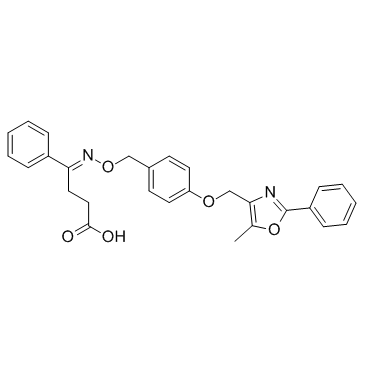250601-04-8
| Name | (4E)-4-[[4-[(5-methyl-2-phenyl-1,3-oxazol-4-yl)methoxy]phenyl]methoxyimino]-4-phenylbutanoic acid |
|---|---|
| Synonyms |
Imiglitazar
TAK-559 (E)-4-(4-((5-Methyl-2-phenyloxazol-4-yl)methoxy)benzyloxyimino)-4-phenylbutanoic acid (E)-4-[4-(5-methyl-2-phenyl-4-oxazolylmethoxy)benzyloxyimino]-4-phenylbutanoic acid Imiglitazar [INN] (E)-4-[4-(5-methyl-2-phenyl-4-oxazolylmethoxy)benzyloxyimino]-4-phenylbutyric acid (E)-4-{4-[(5-methyl-2-phenyl-1,3-oxazol-4-yl)methoxy]benzyloxyimino}-4-phenylbutyric acid |
| Description | Imiglitazar (TAK559) is a potent and dual human PPARα and PPARγ1 agonist with EC50 values of 67 and 31 nM. |
|---|---|
| Related Catalog | |
| Target |
PPARγ1:31 nM (EC50) PPARα:67 nM (EC50) |
| In Vitro | TAK-559 is a partial agonist for hPPARg1 with about 68% of maximal activation obtained with rosiglitazone, a known PPARγ agonist. PPARy is significantly activated at a high concentration (10 μM) of TAK-559. Competition-binding assays using radiolabeled ligand indicates that the transactivation of all hPPAR subtypes by TAK-559 is due to direct binding of TAK-559 to each subtype. TAK-559 also recruit the coactivator SRC-1 to each of hPPARγ1 and hPPARα, and to dissociate the corepressor NCoR from each of hPPARγ1 and hPPARα[1].TNFα- or IL-1β-induced THP-1 cell attachment to cultured endothelial cells is significantly reduced in the presence of 10 μM TAK-559. The secretion of monocyte chemoattractant protein-1 (MCP-1) from endothelial cells is reduced by 36% in the presence of 10 μM TAK-559, accompanied with the decreased mRNA expression in the cells. The proliferation and migration of cultured smooth muscle cells are significantly decreased in the presence of TAK-559[2]. |
| In Vivo | TAK-559 treatment results in significant elevation of circulating high-density lipoprotein (HDL) cholesterol levels, consisting of an increase in large HDL particles and a decrease in small dense HDL particles. Plasma triglyceride and apolipoprotein B-100 levels decrease, whereas apolipoprotein A-I increasesduring TAK-559 treatment. Hyperinsulinemia and insulin resistance are significantly corrected with the highest dose of 3.0 mg/kg per day in these prediabetic monkeys. In addition, no adverse effects on representative liver function parameters are observed during the study period[3]. |
| Kinase Assay | Competition binding assays are performed with cell extract containing hPPARδ and 20 nM [3H]L-783483 in the presence of indicated concentrations of TAK-559 (1, 10, 100 μM) or Iloprost. Data are expressed as the percentage of specific binding in the absence of competitor (vehicle (V) (1% DMSO))[1]. |
| Cell Assay | COS-1 cells are cotransfected with expression plasmid for full-length hPPARγ1 as a VP16 fusion protein, GAL4-SRC-1 (A) or GAL4-NcoR (B) expression plasmid and (UAS)5-tk-Luciferase reporter plasmid. Cells are cultured in the presence of TAK-559 (0.01, 0.1, 1 μM) or rosiglitazone for 2 days. The cell extracts are assayed for luciferase activity[1]. |
| References |
| Molecular Formula | C28H26N2O5 |
|---|---|
| Molecular Weight | 470.51600 |
| Exact Mass | 470.18400 |
| PSA | 94.15000 |
| LogP | 6.01470 |
| Storage condition | 2-8℃ |
